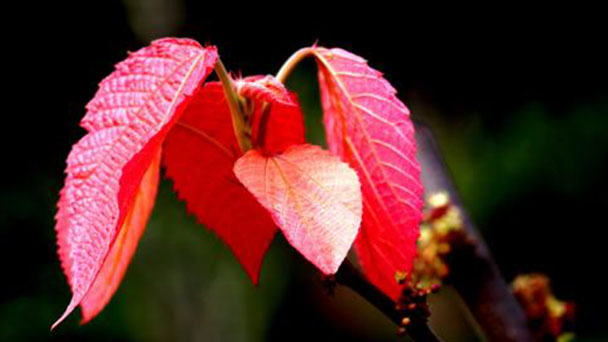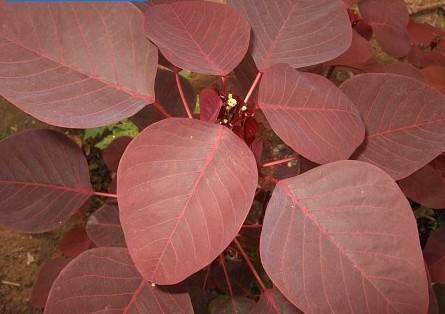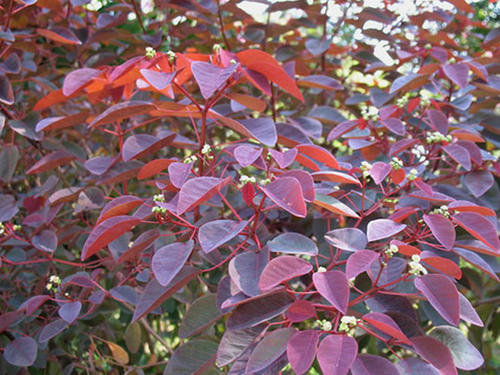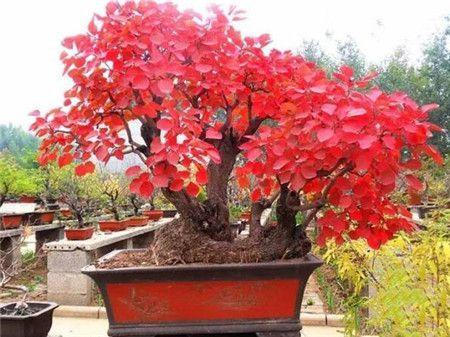Caribbean Copper Plant (Euphorbia Cotinifolia) Profile
Written by Maggie
Sep 27 2021

The Caribbean Copper Plant (Euphorbia cotinifolia), also called Mexican Shrubby Spurge, Red Spurge, Smoke Tree Spurge, Smoketree Spurge, Tropical Smokebush, is a plant of the family Euphorbia, native to India and tropical Africa. Caribbean Copper Plant is an evergreen tree, 13 -- 15 (19) m tall, 12 -- 17 cm in diameter. Leaves are 3-whorled, oblong-ovate, 2-6 cm long and 2-4 cm wide, apex obtuse, base sub truncate; The main veins are obvious on both sides, the number of lateral veins is pairs, the spontaneous veins are on both sides, nearly parallel, not reaching the leaf margin but netted; Margin is entire; Caribbean Copper Plant is red on both sides; Petiole is 2 -- 9 cm long, reddish.
Caribbean Copper Plant Picture

Caribbean Copper Plant Characteristics
Caribbean Copper Plant Leaf
Caribbean Copper Plant (Euphorbia cotinifolia) is an evergreen tree with a height of 13-19 m and a diameter of 12-17 cm.
Leaves of caribbean copper plant are 3 whorled, oblong-ovate, 2-6 cm long and 2-4 cm wide, apex obtuse, base sub truncate; The main veins are obvious on both sides, the number of lateral veins is pairs, the spontaneous veins are on both sides, nearly parallel, not reaching the leaf margin but netted;
Caribbean Copper Plant Flowers
Inflorescences of Caribbean copper plant (Euphorbia cotinifolia) are at apex of bifid branches, with stalks ca. 2 cm long;Involucral bracts broadly campanulate, 2.5 -- 3 mm tall, ca. 4 mm in diam., margin 4-6 lobed, lobes triangular, margin hairy; Caribbean Copper Plant has 4-6 glands, semicircular, dark green, margin with white appendages, margin of appendages divided. Male flowers are numerous; Bracts are filiform; Female flower stalks protrude outside involucre; Ovary is trigonal, longitudinal sulcus conspicuous.
Caribbean Copper Plant Fruit
Capsule of Caribbean Copper Plant is triangulate ovate, ca. 5 mm high, ca. 6 mm in diameter, smooth glabrous. Seeds are subglobose, ca. 3 mm in diam., brown, ventral with dark furrows;
Caribbean Copper Plant Care
Size & growth
Caribbean Copper Plant (Euphorbia cotinifolia) is a fast-growing plant. It can develop rapidly in heat temperatures, attaining a peak of 6′ – 8′ feet.
Cutting it lower back helps keep a shorter, bushier boom with pink stems and crimson heart-shaped leaves.
The reddish coloration of Caribbean copper plants nearly has a copper or rust-colored hue to it.
Flowering
The plant produces tiny plants with creamy-white petals on faded yellow bracts forming at the guidelines of the lengthy stems.
Due to their small size, the plant life is no longer very showy. They don’t produce a fragrance, either, however are fascinating to seem to be at.
The plant can flower year-round.
Light & temperature Care
Outside of USDA hardiness zones 9 to 11, hold the plant indoors at some stage in the winter.
Caribbean Copper Plant (Euphorbia cotinifolia) can't take care of frost or extraordinarily dry conditions.
The tropical smoke bush grows fantastic in vivid mild or full sun, however it can tolerate a little bit of shade.
Caribbean Copper Plant prefers warm, humid conditions.
Watering & Fertilization Care
Water many times at some point of the developing season and solely use liquid fertilizer at some stage in the hotter months.
Unlike most succulents, Caribbean Copper Plant (Euphorbia cotinifolia) does not now take care of lengthy intervals of drought well, consequently it’s now not very drought tolerant.
If delivered indoors for the winter, it can also no longer require widespread watering.
Check it each few days, and water as needed.
If the leaves of the Caribbean Copper Plant begin to droop, it’s possibly getting too good a deal of water.
Soil & Transplanting Care
Use mild and porous well-drained soil to make certain the plant receives greatest drainage.
If the soil incorporates too much clay or sand, add compost or peat moss to make it extra porous.
Repot the plant each and every yr or two, shifting up to a large container as needed.
If allowed to grow, the Caribbean Copper Plant (Euphorbia cotinifolia) can attain up to 8’ toes tall and may also sooner or later require a massive pot to maintain it from tipping over.
Transplant the plant in the late spring, earlier than its bloom time.
Pruning Care
To motivate bushier growth, pinch the tops of younger plants.
With older plants, trim lower back the stems in the early spring to pressure new growth.
NOTE: When grooming the Caribbean Copper plant, use warning to keep away from getting the milky sap on your arms or arms.

Caribbean Copper Plant Propagation
Cuttings furnish the first-rate way to propagate Caribbean Copper Plant.
Use semi-hard or woody cuttings. Softwood cuttings additionally work however require greater warmness and humidity to take root.
For the high-quality results, take hardwood cuttings with a thickness matching a popular pencil.
If possible, take cuttings in the early spring when slicing returns the plant.
Leave some of the leaves and aspect stems on the cuttings if the younger vegetation will acquire adequate daylight and moisture. Otherwise, get rid of the leaves earlier than planting.
After reducing the plant, let the sap dry out.
Avoid touching it, as it may also reason pores and skin irritation.
Wait for the sap to dry, and then dip the hints of the cuttings in rooting hormone.
Plant in a pot containing porous propagation mix.
The principal consideration is humidity.
Keep the younger Caribbean Copper Plant flowers in a humid spot.
If the room doesn’t remain humid, mist the cuttings day by day until they take root.
Caribbean Copper Plant Pests & Diseases
The largest risk to the Caribbean Copper Plant is over-watering.
When over-watering and no longer imparting the plant with adequate sunlight, it might also start to improve mildew or fungus and appeal to pests.
Treat pest troubles with miticide or pesticides, relying on the threat.
Spraying the leaves with water might also additionally assist get rid of small bugs or spider mites.
Fungicide helps quit the unfold of the fungus, however extreme fungal infections may additionally require the disposal of the whole plant.
Over-watering the plant whilst making sure it receives sufficient warmness and daylight can lead to drooping leaves.
If the leaves of Caribbean Copper Plants (Euphorbia cotinifolia) begin to droop, make certain the soil has top drainage and restriction watering till the fitness of the plant returns.
Besides drooping leaves, watch out for the sap. The stems produce a sap recognized to motive pores and skin irritation. It may additionally additionally purpose digestive misery if ingested.
Keep Caribbean Copper Plant away from small teens and pets, and use warning when trimming returned or coping with the plant.
To defend the skin, put on gloves earlier than trimming the stems or taking cuttings for propagation.
Caribbean Copper Plant Habits
Caribbean Copper Plant likes sunny, warm and humid environments. The soil should be loose, fertile and well drained. During the growing period, water and fertilize thoroughly. Proper trim and shaping. Keep warm in winter, properly control watering, overwintering temperature above 8℃.
Propagation methods of Caribbean Copper Plant
Caribbean Copper Plant can be propagated by cutting and layering, which is generally carried out in spring and summer.
Caribbean Copper Plant Distribution
Caribbean Copper Plant distributes in tropical America; China's Fujian, Taiwan has been cultivated in recent years, do street trees, leaves can be ornamental red;In recent years, Beijing greenhouse also began to cultivate.
Caribbean Copper Plant Uses
Caribbean Copper Plant (Euphorbia cotinifolia) is an excellent landscape plant with extremely beautiful leaves. It can be grown on the open ground or in pots.
Caribbean Copper Plant has beautiful leaves and purple leaves all the year round. It is an excellent tree with colorful leaves.Suitable for planting in the garden as landscape trees.

Latest Updated
- Benefits of Bugleweed - 7 Science-backed Health Benefits
- Bugleweed Dangers & Side Effects - Is It Poisonous?
- How to Plant Evergreen Trees - What You Should Know
- When to Plant Evergreens - Grow Guide for Evergreen Trees
- 12 Wonderful Evergreen Shrubs for Your Garden
- 12 Popular Evergreen Plants with Pictures for Beginners
- When And How To Prune A Lilac Bush Like a Pro
- How to Grow & Care for Lilac Vine (Hardenbergia Violacea)
- Japanese Lilac Tree (Syringa Reticulata) Care & Propagation Guide
- Shumard Oak Pros and Cons - What to Know
Popular Articles
- Winter maintenance of Antirrhinum Majus
- How to Grow Terminalia Mantaly Tree
- How to Grow and Care for Crossostephium Chinense
- How to grow Antirrhinum Majus in spring
- Peristeria Elata (Dove Orchid) Profile: Info & Care Guide
- Underwatered Snake Plant (Sansevieria Trifasciata) - Signs And How To Fix
- How to Care for Brazilian Jasmine Plant (Mandevilla Sanderi)
- How to Grow & Care for Graptopetalum Purple Delight in Summer
- Rosa Chinensis (China Rose): Plant Growing & Care Tips
- How to Care for Baby Sun Rose (Aptenia Cordifolia)